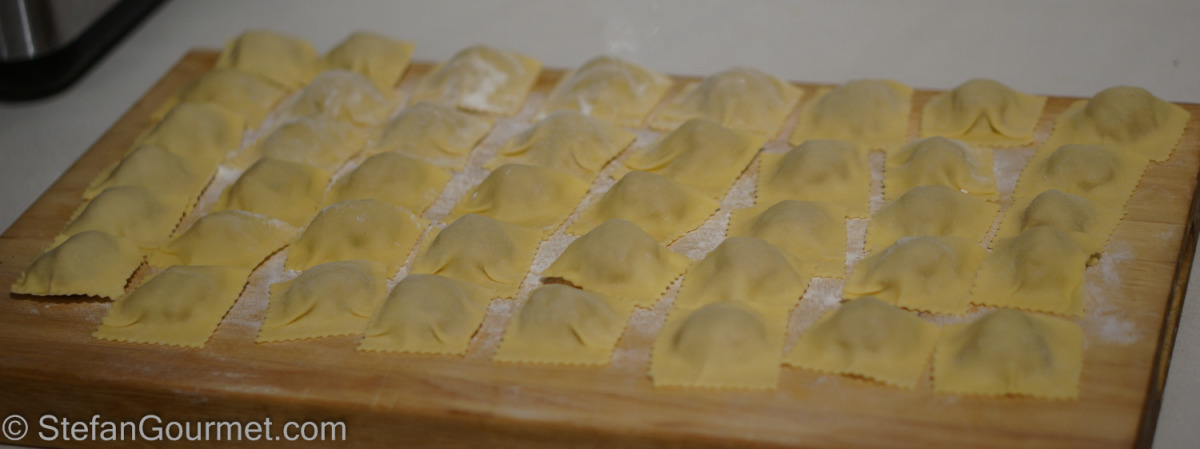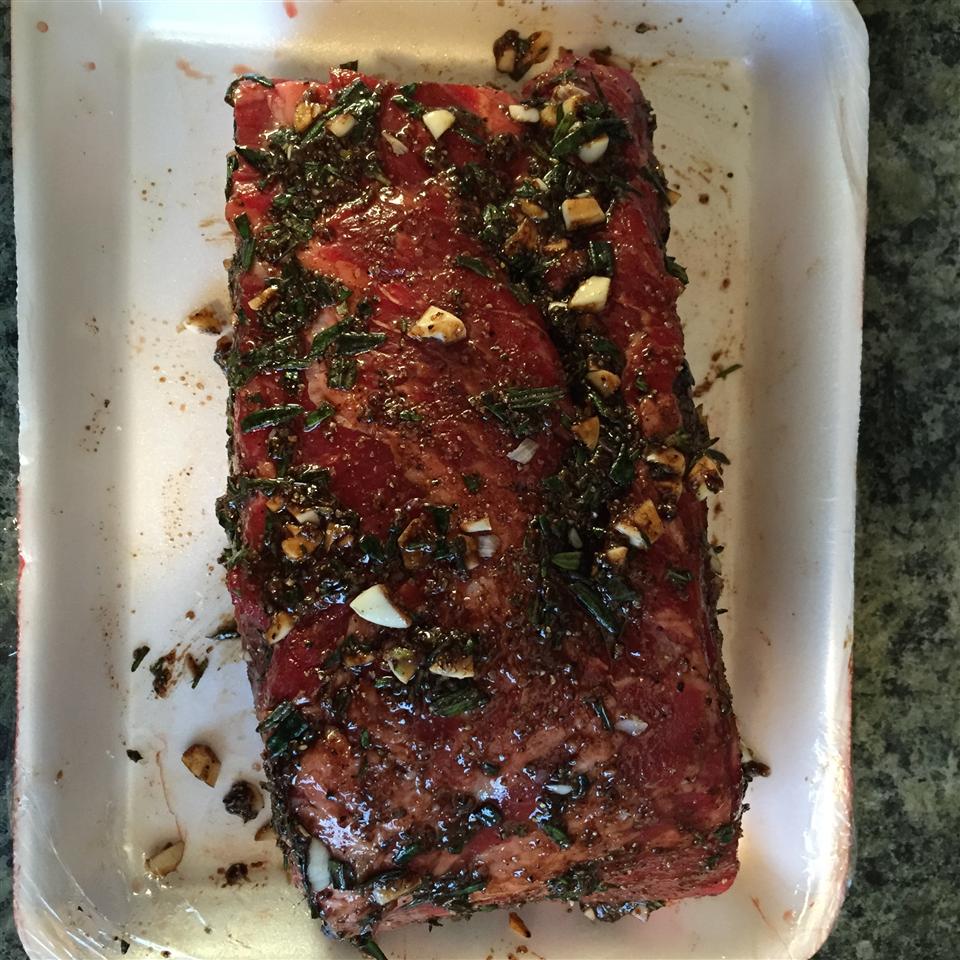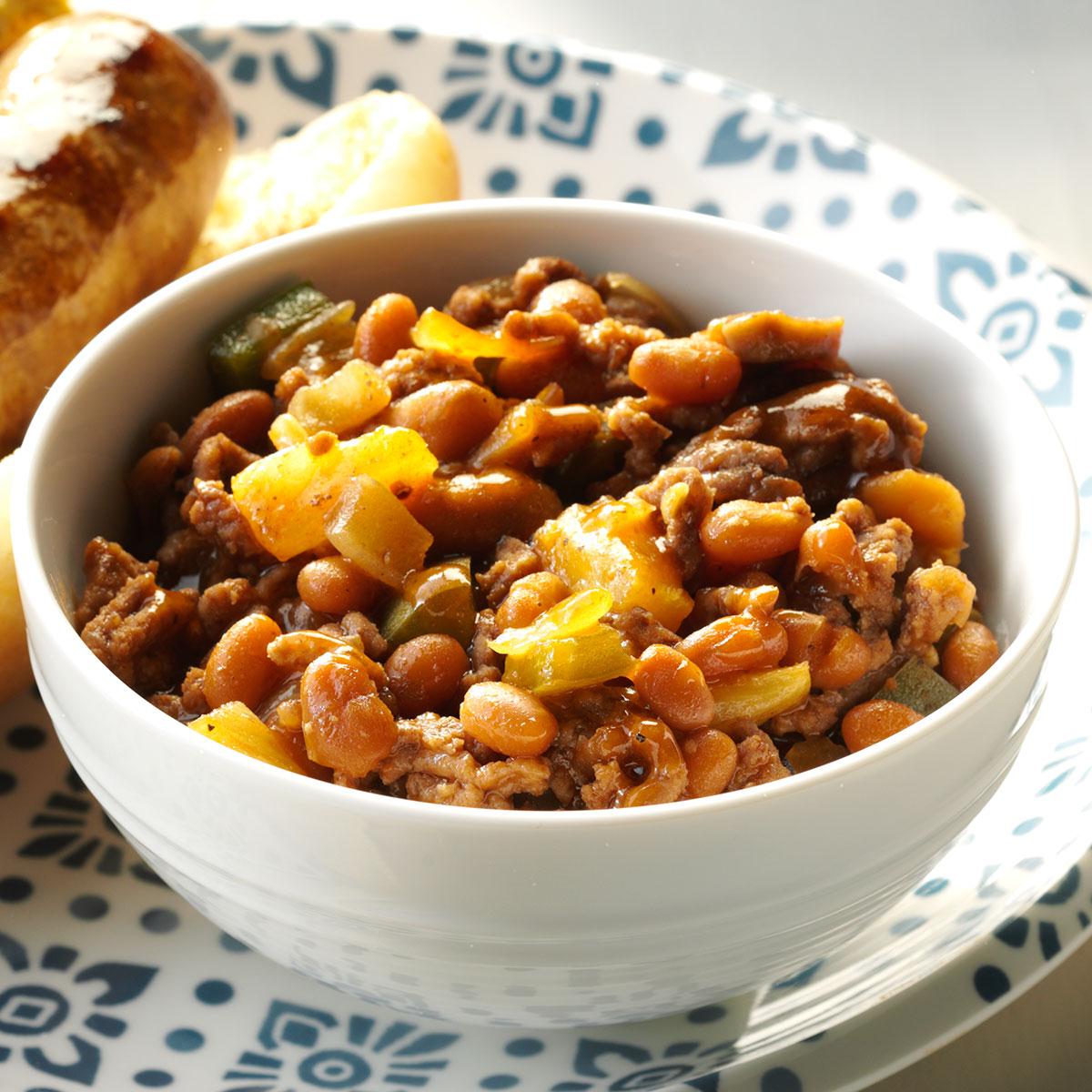**Ravioli:**
Ravioli, a delectable Italian dish, is a type of pasta comprising a filling enveloped in thin layers of dough. These delicate parcels of goodness can be prepared in various ways, each offering a unique culinary experience. This article presents three distinct ravioli recipes that cater to diverse preferences and dietary restrictions. From the classic meat-filled ravioli to the vibrant vegetarian option and a gluten-free alternative, this comprehensive guide provides step-by-step instructions to create ravioli masterpieces in the comfort of your own kitchen. Whether you're a seasoned home chef or a novice cook seeking to impress your loved ones with a homemade pasta dish, these recipes have everything you need to craft perfect ravioli that will tantalize your taste buds.
RAVIOLI DOUGH
Provided by Tyler Florence
Time 1h10m
Yield 24 ravioli
Number Of Ingredients 5
Steps:
- In an electric mixer fitted with a dough hook, combine flour and salt. Add eggs 1 at a time and continue to mix. Drizzle in oil and continue to incorporate all the flour until it forms a ball. Sprinkle some flour on work surface, knead the dough until elastic and smooth. Wrap the dough in plastic wrap and let it rest for about 30 minutes to allow the gluten to relax.
- Cut the ball of dough in half, cover and reserve the dough you are not immediately using to prevent it from drying out. Dust the counter and dough with flour. Form the dough into a rectangle and roll it through the pasta machine, 2 or 3 times, at its widest setting. Guide the sheet of dough with the palm of your hand as it emerges from the rollers. *Reduce the setting and crank the dough through again, 2 or 3 times. Continue until the machine is at its narrowest setting. The dough should be paper-thin, about 1/8-inch thick.
- Dust the counter and dough with flour, lay out the long sheet of pasta. Brush the top surface of dough with egg wash. Drop 1 tablespoon of cooled filling about 2-inches apart on half the sheet of pasta. Fold the unfilled half over the filling. With an espresso cup or fingers, gently press out air pockets around each mound of filling and form a seal. Use a crimper to cut each pillow into squares. Check to make sure the crimped edges are well sealed before cooking. If making ravioli in advance, dust with cornmeal to prevent them from sticking.
- Cook the ravioli in plenty of boiling salted water for 10 to15 minutes. Ravioli will float to the top when cooked so be careful not to overcrowd the pot. Lift the ravioli from water with a large strainer or slotted spoon. Plate the pasta, top with sauce and grated cheese before serving. Garnish plate with chopped herbs and toasted pine nuts.
- *For Herb-Patterned Pasta: Follow the standard recipe given above and roll it out to a medium-thick sheet. Next, take well-washed leafy herbs such as, basil, flat-leaf parsley and tarragon, pinch away the stems so only the leaves remain. Hand press the fresh herbs on the dough's surface at 1-inch intervals. Fold the dough over itself and run the "sandwich" through the pasta machine at a thin setting. The leaves will stretch and pattern the pasta. Continue making ravioli as indicated in the procedure.
RAVIOLI DOUGH

This is the recipe is used by Chef Thomas McNaughton of San Francisco restaurant Flour + Water whenever he makes ravioli or a variety of other stuffed pastas, such as his Pumpkin Tortelloni with Sage and Pumpkin Seeds. McNaughton emphasizes that pasta is easy to underknead but virtually impossible to overknead (unlike bread, where each type has its sweet spot or ideal kneading time). That said, even though the dough cannot be overkneaded, it can spend too much time on the worktable-and, as a direct result, start to dehydrate and be more difficult to form into its final shape. For best results, he recommends kneading the dough for 10 to 15 minutes.
Provided by Kelton.A
Categories < 30 Mins
Time 20m
Yield 20 OZ
Number Of Ingredients 5
Steps:
- Place the flour on a dry, clean work surface, forming a mound about 8 to 10 inches (20 to 25 cm) in diameter at its base. Sprinkle the salt in the middle of the mound. Using the bottom of a measuring cup, create a well 4 to 5 inches (10 to 13 cm) wide, with at least 1/2 inch (12 mm) of flour on the bottom of the well.
- Slowly and carefully add the whole eggs, egg yolks and olive oil to the well, treating the flour as a bowl. Using a fork, gently beat the eggs without touching the flour walls or scraping through the bottom to the work surface.
- Then, still stirring, slowly begin to incorporate the flour "walls" into the egg mixture, gradually working your way toward the outer edges of the flour, but disturbing the base as little as possible. If the eggs breach the sides too soon, quickly scoop them back in and reform the wall. Once the dough starts to take on a thickened, paste-like quality (slurry), slowly incorporate the flour on the bottom into the mixture.
- When the slurry starts to move as a solid mass, remove as much as possible from the fork. Slide a pastry scraper or spatula under the mass of dough and flip it and turn it onto itself to clear any wet dough from the work surface. At this point, with your hands, start folding and forming the dough into a single mass. The goal is to incorporate all the flour into the mass, and using a spray bottle to liberally spritz the dough with water is essential. It is a very dry dough, and it is very important to generously and constantly spritz it with water to help "glue" any loose flour to the dry dough ball.
- When the dough forms a stiff, solid mass, scrape away any dried clumps of flour from the work surface, which, if incorporated in the dough, will create dry spots in the final product.
- To knead the dough, on your work surface, drive the heel of your dominant hand into the dough. Push down and release, and then use your other hand to pick up and rotate the dough on itself 45 degrees. Drive the heel of your hand back in the dough, rotate and repeat for 10 to 15 minutes. When the dough is ready, it will stop changing appearance and texture. The dough will be firm but bouncy to the touch and have a smooth, silky surface, almost like Play-Doh. Tightly wrap the dough in plastic wrap before proceeding as directed with your recipe. Makes about 20 oz. (625 g) of dough.
TOASTED RAVIOLI AND BASIC RAVIOLI DOUGH
Provided by Robert Irvine : Food Network
Time 2h20m
Yield 40 (2-inch) ravioli
Number Of Ingredients 15
Steps:
- For the dough: Sift the flours and a pinch of salt into a bowl. Whisk together the eggs, oil, and 2 tablespoons water in a separate bowl. Pour the flour mixture onto a clean dry work surface and form a small well in the center. Pour half of the egg mixture into the well and, using a fork, begin to incorporate the flour into the egg mixture. Once absorbed, incorporate the remaining egg mixture and knead by hand until all of the liquid is absorbed, 5 to 6 minutes, flouring your work surface as needed to ensure the dough doesn't stick. Roll the dough into a ball, cover with plastic wrap, and let rest in the refrigerator for 1 hour. For the filling: Mix together all of the ingredients until fully incorporated in a bowl. Chill in the refrigerator for at least 20 minutes, or up to 1 hour. To assemble: Divide the rested dough into 2 equal-size pieces and roll out on a floured work surface to a thickness of 1/8-inch. On 1 dough sheet, distribute tablespoon-sized portions of the filling, at least 2 inches apart. Brush the edges of the dough with the egg wash. Carefully lay the second sheet of dough on top and press the edges shut with your fingertips. Use a round 1 1/2-inch ravioli cutter to portion out ravioli pieces, pinching the edges shut to ensure no air is trapped inside. In a large heavy-bottomed saucepan, pour enough oil to fill the pan about a third of the way. Heat over medium heat until a deep-frying thermometer inserted in the oil reaches 350 degrees F. Whisk the remaining 3 eggs and cream in a shallow bowl. Place the breadcrumbs and Parmesan into another shallow bowl and stir to combine. Dredge the ravioli in the egg mixture, followed by the breadcrumb mixture. Working in batches, carefully drop the ravioli into the saucepan and fry until golden brown, 2 to 3 minutes, making sure that the oil comes back up to temperature in between batches. Place directly onto a cooling rack lined with aluminum foil to drain any excess oil. Serve with warm tomato sauce and freshly grated Parmesan.;
- Serving suggestion: tomato sauce and freshly grated Parmesan.
PASTA DOUGH FOR LOBSTER RAVIOLI

Use this homemade pasta dough from Corton chef Paul Liebrandt to make his spectacular Lobster Ravioli with Lobster Vinaigrette.
Provided by Martha Stewart
Categories Food & Cooking Ingredients Egg Recipes
Yield Makes enough for 12 (2-inch-round) raviolis
Number Of Ingredients 4
Steps:
- In a large bowl, whisk together egg yolks and eggs; add olive oil and whisk until slightly emulsified. Transfer to the bowl of a food processor and pulse for 5 seconds. Add flour and pulse until a cohesive ball of dough forms, about 30 seconds.
- Remove dough from food processor. Add a pinch of flour to work surface and knead until smooth, about 2 minutes. Wrap with plastic wrap and let rest in a cool place 2 hours before using.
RAVIOLI DOUGH

Steps:
- In an electric mixer with a dough hook, mix 2 cups flour and salt. Add eggs 1 at a time and continue to mix. Drizzle in oil and continue to incorporate the remaining flour until it forms a ball. Sprinkle some flour on work surface, knead the dough until elastic and smooth. Wrap the dough in plastic wrap and let it rest for about 30 minutes. Cut the ball of dough in half, cover the dough you are not immediately using to prevent it from drying out. Dust the counter and dough with flour. Form the dough into a rectangle and roll it through the pasta machine, 2 or 3 times, at its widest setting. Guide the sheet of dough with the palm of your hand as it emerges from the rollers. *Reduce the setting and crank the dough through again, 2 or 3 times. Continue until the machine is at its narrowest setting. The dough should be paper-thin. If no pasta machine is available, a roller may be used. Place the dough between floured sheets of waxed paper to prevent it sticking. Dust the counter and dough with flour, lay out the long sheet of pasta. Brush the top surface of dough with egg wash. Drop 1 tablespoon of cooled filling about 2-inches apart on half the sheet of pasta. Fold the unfilled half over the filling. With a very small cup or fingers, gently press out air pockets around each mound of filling and form a seal. Use a crimper to cut each pillow into squares. Check to make sure the crimped edges are well sealed before cooking. If making ravioli in advance, dust with cornmeal to prevent them from sticking. Cook the ravioli in plenty of boiling salted water for 10 to15 minutes. Ravioli will float to the top when cooked so be careful not to overcrowd the pot. Lift the ravioli from water with a large strainer or slotted spoon. Plate the pasta, top with sauce and grated cheese before serving.
Tips:
- Use the right flour: All-purpose flour is the most common type of flour used for ravioli dough, but you can also use bread flour or semolina flour for a chewier texture.
- Make sure the water is cold: Cold water helps to keep the gluten in the flour from developing too much, which can make the dough tough.
- Knead the dough until it is smooth and elastic: This will help to develop the gluten in the flour and make the dough strong enough to hold the filling.
- Let the dough rest before rolling it out: This will help to relax the gluten and make the dough easier to work with.
- Roll the dough out thinly: The thinner the dough, the more delicate the ravioli will be.
- Use a ravioli mold or a cookie cutter to cut out the ravioli: If you don't have a ravioli mold, you can use a cookie cutter to cut out circles of dough and then fold them over the filling.
- Seal the ravioli well: Make sure to press the edges of the ravioli together firmly to prevent them from opening during cooking.
- Cook the ravioli in boiling salted water until they float to the top: This usually takes about 2-3 minutes.
- Serve the ravioli with your favorite sauce: Ravioli can be served with a variety of sauces, such as tomato sauce, pesto sauce, or Alfredo sauce.
Conclusion:
Ravioli is a delicious and versatile dish that can be enjoyed by people of all ages. With a little practice, you can easily make ravioli at home using the tips and recipes provided in this article. So next time you're looking for a new and exciting meal to try, give ravioli a try!
Are you curently on diet or you just want to control your food's nutritions, ingredients? We will help you find recipes by cooking method, nutrition, ingredients...
Check it out »
#30-minutes-or-less #time-to-make #preparation #5-ingredients-or-less #easy #from-scratch
You'll also love







